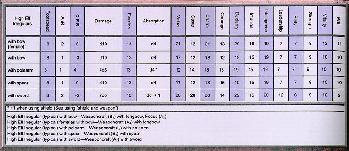
Battlestorm
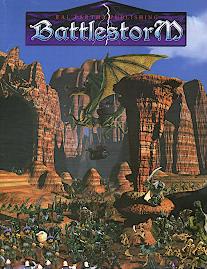
- Description
- Detailed Description
- Reviews
- Links
Back to FANTASY MASS-COMBAT RULES
Battlestorm is the first product in the Fables system, which will eventually provide an integrated set of role-playing and tabletop combat rules. This game is the combat module, covering everything from gladiatorial duels to the fighting of massed armies. Future volumes will cover role-playing, magic, psionics, and clerics/healing.
| The World |
|---|
| Buying an Army |
| Setting Up the Battle |
| The Sequence of Play |
| Combat |
| The Advanced Rules |
The World
Great fantasy stories start with reality - reality with a twist. A measure of reality gives fantasy a resonance, but the fantastic, the mythological, makes old ideas and themes seem new and unique. Unfortunately, when the fantastic becomes the mundane (i.e., when orcs are always bad and dwarves are always good, when humans and elves always ally), the story loses its power. We're created a world where old stereotypes are viewed from fresh angles, and that begs the question ... what will happen? Fables is about asking you questions - and letting your imagination answer. - Battlestorm, Introduction, pg. 4 |
Battlestorm takes place on a world called Lharna, which in many ways is similar to Earth. Its history consists of the following ages:
| Age of Giants | World is ruled by giants and titans, with all other races (elves, dwarves, others) in servitude. Lasts 100 million years. Ends when time-travelling humans steal the secret of magic and give it to the elves. |
|---|---|
| Age of Dragons | Dragons lead the anti-giant revolt, then war among themselves for 5 million years. The last battle cracks the world's sole continent into many pieces, and the destruction causes the dragons to regain their wisdom and relinquish power. |
| Age of Fairy | The world is blighted due to the overuse of magic, and the Netherworld is now able to invade Lharna through dimensional cracks. The fairies spend a million years redeeming the land, sharing their wealth with elves, dwarves, goblins, trolls and orcs - but their friends desert them when the Undead must be fought. To save Lharna from the Netherworld, the fairies cast a reality-altering spell known as the Androclysm... |
| Age of Man | Due to the fairy magic, humans from Earth's medieval period find themselves on Lharna. Simultaneously, a plague breaks out among the elves. Over the next 1400 years, the humans carve out their own empires, fusing the cultures they brought from Earth into new combinations. |
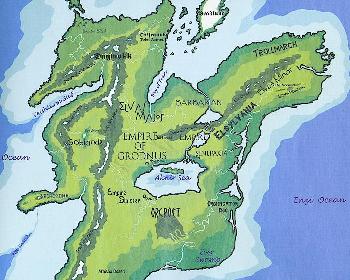
The rulebook also provides brief descriptions of selected lands on the continent of Tolaria:
- Dagmokk is the neo-Nazi, expansionist Dwarven Empire which may have over-extended its reach.
- The trolls were once the servants of the giants, but now they dwell in Trollmarch and dream of their former glories.
- Elvas Minor is a High Elf nation. Its policies are long-term, entangling alliances are avoided, and humans are looked upon with distrust.
- Sinepaxia is a loose confederation of human feudal states. (Other humans live as barbarians and reavers, or dwell in lands not detailed in this book.)
- The goblins once ruled a mighty land (the Goblands), but climate changes have turned them into clans of nomadic merchants.
- Orcroft is the arid homeland of the orcs, a warrior people who have formed an alliance with humans against the Necrozona.
- Adjacent to an oceanic trench where lies a rip in reality, Necrozona is the land of the Undead - zombies, skeletons, and ghosts.
Buying an Army
Before play can begin, each player must have an army. Together they decide the points available for the fight, then spend those points to buy their armies, figure-by-figure.
Certain guidelines apply to army design:
- Half of the points must be spent on common troops
- Only a third of the army can have projectile weapons
- No single character can be worth more than half the total points available (optional rule)
- Only a fourth of the army can consist of mercenaries or allies
- Limits apply to the amount of points which can be spent on dragons, monsters, and war machines
There are no "army lists" to constrict players' choices, but the reference charts act as a practical limit to what any army may contain. Seventeen pages of charts list the stats of the defined troop types.
Figures are formed into Units of one or more figures. Players are free to organize their units as they please (though the Advanced Rules sometimes penalize units of mixed troop types).
Setting Up the Battle
Although a battle may take hours or days or weeks to develop, a battle game starts at the point when the combatants are very close to engaging. Instead of playing out the entire war, the players are taking over command after the army marched to this point in time and space... - Battlestorm, Placing Troops, pg. 17 |
Terrain for the battle may be set up freely. Afterwards, the players dice for selection of their "home" table edge.
Players then divide their forces into an equal number of Placement Units of roughly the same point values. They then take turns placing these groups onto the tabletop. There is no connection between actual units and placement units, and figures in the same placement unit can be placed in different parts of the playing area.
During deployment, figures may be placed anywhere on the tabletop, within these limitations:
- Can't place troops within 1" of enemy troops
- Most common melee troops must be within a double-move of the center of the table
- Most common missile troops must be within range of the center of the table
- Flying creatures cannot be higher than 6"
- Must place all troops on player's side of the table
Prior to the battle, an equal number of figures on each side (usually 2 or 3) must be designated as Champions.
The object of the "standard" game is to drive the opposing army from the table or to receive their surrender.
The Sequence of Play
The order in which things happen is one of the most unique and intriguing aspects of Fables. In many games, you move and then your opponent moves, you move and then your opponent moves. That method is very orderly; it's neat and tidy ... but not much like a real battle. - Battlestorm, Sequence of Play, pg. 19 |
At the start of the turn, players roll to see who has the Initiative. The player who wins the roll must Activate one of his units. After that unit takes its Actions, the players again roll to see who must activate the next unit. The turn continues until all units have been activated once.
A unit may take more than one Action per activation round, depending on the rules for the different actions involved. The possible Actions include:
- move
- declare an attack, or fire projectile weapons
- brace [ready to attack targets of opportunity]
- stand ready [as above, but for projectile weapons]
- disengage
- divide up (split the unit)
- join another unit
- search
- hide
- hold [do nothing]
- recover/reload [applies to war machines reloading, or troops with slow or awkward weapons]
- rally [attempt to restore a routing unit]
An activated unit must perform its actions according to a strict sequence of play:
- Search
- Declare Melee Attacks
- Change Formation
- Move
- Check for Fear
- Resolve Combat
- Resolve routs and pursuits
In Fables, you never know who is going to move next. There is never a time in a battle (or in this game) when you just sit around and watch the enemy take his turn....The game flows quickly from one side to the other stressing action and reaction. - Battlestorm, Sequence of Play, pg. 19 |
During the "Declare Actions" step, the currently activated unit may declare a melee attack on any enemy unit. The unit does not have to follow through on its declaration, but it cannot later in the round attack any enemy which it did not declare against. An enemy unit upon which an attack has been declared has the option of immediately activating (if it has not already activated this turn). If it in turn declares an attack, the target of that attack also has the option of activating.
Thus one attack declaration can set of an entire chain of declarations and activations - a chain reaction called a Battlestorm.
A previously unactivated unit may also choose to activate if an enemy unit comes too near, interrupting the moving unit with its own Actions.
Combat
When combat occurs, it's time to pick up the dice and find out what happened, because anything ... ANYTHING can happen in battle. A great warrior can stumble and fall at his moment of triumph. The mighty can fall to the humble in a single stroke. The best armor offers no protection against a perfectly executed stab with a lowly ice pick. - Battlestorm, The Attack, pg. 34 |
There are two forms of combat -- Projectile and Melee. All combat is worked out on an individual vs. individual basis.
Projectile Combat
Projectile weapons are anything that can attack at a distance, such as a bow or firearm.
Each weapon type is assigned to one of seven range classes, which determines its minimum and maximum effective ranges. The class also determines the penalty for shooting at targets beyond maximum effective range. A figure can attack any target within range, and to which it has a clear Line of Sight.
To resolve the attack, a target number must be determined. This is done by adding together the attacker's Combat Error Rating (C.E.R.) and the defender's Evasion rating. To score a hit, the attacker must roll this number or higher with a 30-sided die.
Rolling a "30" is an automatic hit (except when attacking beyond effective range). If the target number was 30 or less, the hit bypasses armor as well. Rolling a "1" is a Fumble (an automatic miss). When powerful characters fumble, they must roll on the Fumble Chart to determine what happened (weapon broken or dropped, attack hits friend or self, attacker loses footing, etc.).
If a hit is scored, damage is rolled for. The reference charts list how many and what types of dice are thrown for the damage roll. If the attacker rolls the maximum possible on any die, he may keep the score and re-roll the die.
The defender then rolls to determine his Absorption - due to armor, natural toughness, magical protection, etc. - according to the formula provided on the reference chart for that troop type. Absorption is subtracted from damage, and any remaining damage counts against the defending figure.
| EXAMPLE OF PROJECTILE COMBAT: Let's say that I've won Initiative. In this case, it seems to be wise to activate my Elven Bow-Women and have them fire on a troublesome enemy - a large unit of enemy Savages (braves with swords). (Note that my elf women can fire on the savages without giving them a chance to activate, since only Melee declarations allow the enemy a chance to activate.) First, I check to make sure that my target is in range. According to the footnote on the unit reference chart, my elven bow-women have longbows. The weapon chart tells me that a longbow is range class P4. The range table tells me that the minimum effective range is 3", the maximum effective range is 18", and beyond effective range there is a penalty of +2 per inch. (Note that ordinarily I'd look up all this information when filling out my troop cards prior to play, not during the heat of combat.) The savages are about 12" away, definitely in range. The bow-women have a C.E.R. of 6. The savage braves have an Evasion of 12. This means that I must roll (6 + 12 =) 18 or higher to score a hit. I have 11 bow-women, all of whom have 2 attacks per round. We'll resolve just one of those attacks, to show how the process goes: First, I roll a "23" and score a hit (greater than 18). Damage for elven bow-women is a d10. Savages have an automatic Absorption score of "0." I roll a lucky "10" for damage (maximum result possible), which means I get to roll again (an "8"), for a total of 18 points of damage, none of which is absorbed! |
Melee Combat
Combat involving figures at close range - melee combat - is resolved using the same system as for projectile combat, though some special rules apply.
First, due to the Battlestorm system, it is possible for more than one unit to be resolving combat at the same time. If so, the Order of Attack must be determined. The general rule is that if figures are in base-to-base contact, shorter weapons attack first; if figures are separated, longer weapons attack first; if both figures are equivalent, then combat is considered simultaneous. If two units have just come into contact, combat begins at the longest weapon range.
Attack radius and weapon reach is something best measured with an eyeball and not with a tape measure. - Battlestorm, pg. 31 |
Second, just as projectile weapons have effective ranges, melee weapons also have maximum (and sometimes minimum) ranges. There are five classes of melee weapons, with ranges varying from 0" (figures must be in base-to-base contact) to 1". However, the rules suggest refering to the miniatures themselves for a more accurate determination of melee range. Unlike projectile weapons, melee weapons cannot attack beyond their range.
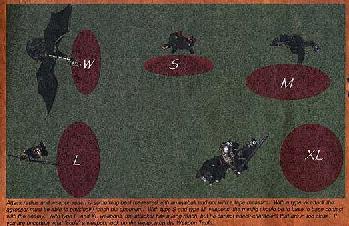
Third, certain figures may have a choice of attacks (as shown on their reference chart). Some figures have multiple weapons. Other figures can use the same weapon in different ways, such as using a bow as a projectile weapon or as a club in melee, or a spear that can be thrown or used with one or two hands. A few figures can opt between making one powerful attack per round, or two weaker attacks per round.
| EXAMPLE OF MELEE COMBAT: The savage braves were reduced in number by the firing of my bow-women, but let's say that in a future round, eight of them charge into base-to-base contact with the poison wyvern. Their approach allows the wyvern, which hasn't done anything this turn, to activate as well. Since both foes are active, who attacks first? First, let's look up the ranges. The wyvern has four attacks - 2 x talons, 1 x bite, and 1 x tail. These weapon types are not covered in the tables, but we'll say that all "body attacks" occur at Wrestling range. The braves have shortswords, which can be used as swords (medium range) or knives (short range). Both short and medium range melee weapons require base-to-base contact. Since the figures moved into combat this turn, they start at the longest weapon range - in this case, medium range due to the swords - and their bases are slightly separated, to indicate they are at "longer" range this round. At "longer" range, the "longer" weapons get first attack... so the humans start swinging! The savages have a C.E.R. of 3 vs. the wyvern's Evasion of 10, so their target number is (3 + 10 =) 13. The Human player rolls eight times - "26, 21, 18, 18, 17, 11, 9, 27" - scoring six hits (six results equal or greater than 13). The savages do "2d6" damage with their swords. The Human player rolls for each attack, with results of "4, 9, 8, 7, 6 and 7". The wyvern has an Absorption of 3d4, and against each attack rolls "8, 4, 8, 10, 4, 7". Comparing the results, the wyvern takes (4 - 8 =) 0, (9 - 4 =) 5, (8 - 8 =) 0, (7 - 10 =) 0, (6 - 4 =) 2, and (7 - 7 =) 0 damage, for a total of 7 points of damage. After the damage is inflicted, the wyvern can attack. All of its attack forms have a C.E.R. of 0 which, against the braves' Evasion of 12, results in target numbers of (0 + 12 =) 12. I roll a "14" (bite), "10" (claw), "9" (claw), and "24" (tail) - the bite and the tail score (greater or equal to 12), but the claws miss. The wyvern's bite damage is "2d10 + 3d8" - rolling five dice, I come up with 25 damage points. The savages have no Absorption, so the targeted brave takes all of the damage. The tail does "2d6 + 3d8" damage - I roll 25 damage points (again!), pulverizing another of the savage attackers. The human victim is unlikely to live, but if he did, he would also have to make a saving roll vs. paralysis (the wyvern's tail is poisonous). At the end of the round, the combatants are moved into base-to-base contact to show they have closed to "shorter" weapon range. Next time, the wyvern gets first attack! |
Proportional Reduction
There is a technique called proportional reduction which can be used when any combat is resolved. The rules suggest using this method to reduce die rolling when large combats are being resolved. The basics are:
- if a figure has multiple attacks, rather than rolling for each attack, roll once and apply the results for each attack
- if a unit has many attacks, the attacker can decide to reduce the number of attacks by a chosen factor, then multiply the results by that factor (for instance, instead of resolving 20 attacks, the player could resolve 5 attacks, each of which count 4 times)
Proportional reduction is used to determine the total number of hits, but damage may still be rolled individually.
Damage
As a result of combat, some figures end up with unabsorbed damage points. What happens next is determined by whether the figure is Common, Hero, or Champion:
- The reference charts indicate the number of Fate points any figure has. Common figures are those which start with no Fate points. Any unabsorbed damage kills them.
- Heroes are, loosely speaking, those figures with one or more Fate points. Each point of damage removes one Fate point; when all the Fate is gone, the figure is dead.
- Champions are designated prior to play, and can originally be Commons or Heroes. Whenever a champion receives damage that would kill him (if he were not a champion), he instead suffers the result of a roll on the Critical Hit tables.
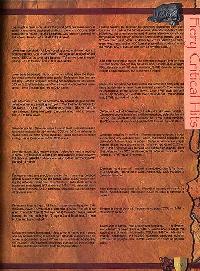
| EXAMPLES OF DAMAGE: In the projectile combat example, a single bow-women did 10 points of damage to a single savage. Since the savage was common, that was more than enough to kill him. Likewise, in the melee combat example, the wyvern's byte damage of 25 points atomizes his savage target. However, also from the melee combat example, the savages did a total of 7 points damage to the wyvern. This is applied against the beast's Fate of 25, reducing it to 18. Let's imagine that the savages did enough damage to reduce the wyvern's Fate to 0, but that the wyvern was a designated champion for the Elven army. In this case, a Critical Hit would be rolled. We decide that the Slashing Critical Hit table matches the weapon type of the savages (shortsword). A percentile roll of "87" results in Foot Cut Off At Ankle. The wyvern suffers a permanent Evasion penalty, and must make saving rolls to avoid routing and to avoid falling down. |
The Advanced Rules
A basic battle can be played using the standard rules. The advanced rules are intended to be added, one at a time, as the players desire. They cover:
| Area-Affecting Weapons | Rules allow for special weapons (such as firearms) to affect an area, rather than a single target. |
|---|---|
| Charging | Units, mounted or unmounted, using "charge weapons" have the special option of making a charge. Charging units can attack multiple ranks, and even multiple units. |
| Courage | Units need to make a Courage check when they take heavy losses, see friendly units flee, or approach frightening creatures. Failing a Courage roll causes a unit to rout, giving the enemy the opportunity to pursue. Optionally, penalties apply to Courage checks due to total losses to each side (breakpoints). |
| Formations | A units may now organize itself into a mob, phalanx, or line, open or closed formation. Formations provide bonuses (and penalties) to movement and combat. |
| Leadership | Players must designate one general per army. Penalties apply to units too far from the general. If the general dies, his units must make saving rolls to avoid leaving the battle. |
| Special Combat Situations | New modifiers apply due to the tactical situation - whether an opponent is on higher ground, attacking from rear or flank, blind, flying, and so forth. |
| Weather | Ten varieties of weather are identified, and can be determined pre-game by a random dieroll. |
